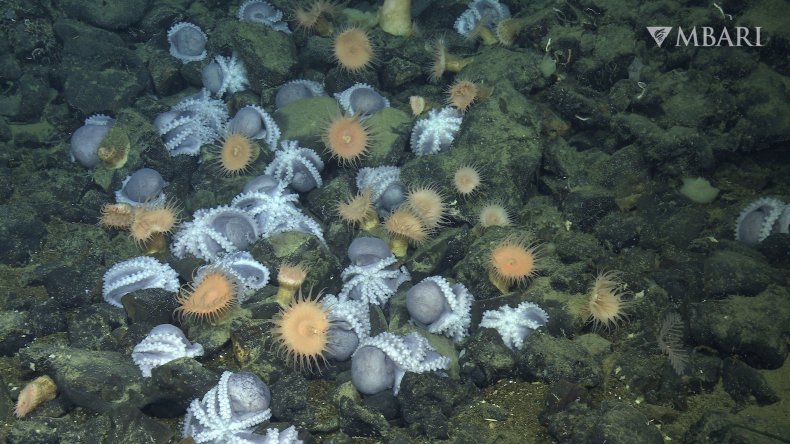Scientists have uncovered the secrets of an "octopus garden" in the deep ocean.
The garden was discovered in 2018 on the seafloor off the Central California coast, sparking questions about its purpose.
Photos of the site show a large number of octopuses—nicknamed "pearl octopuses" as they look like gems from a distance—glowing on the sea floor.
Now a study published in Science Advances has confirmed that the cephalopods migrate to the garden to mate and nest. It is located 10,500 feet below the surface of the ocean, near the Davidson Seamount—a long-extinct underwater volcano.

A group of marine research organisations—the Monterey Bay Aquarium Research Institute (MBARI), the National Oceanic and Atmospheric Administration's Monterey Bay National Marine Sanctuary, the Moss Landing Marine Laboratories, the University of Alaska Fairbanks, the University of New Hampshire and the Field Museum of Natural History—conducted 14 dives with a remotely operated vehicle, to investigate why so many octopuses gather at the site.
It is one of only a few known octopus nurseries in the deep ocean.
Although octopuses tend to be solitary, researchers counted over 6,000 of them at the garden. This is the largest known gathering of octopuses on the planet.
There are likely to be many more at the site, perhaps even 20,000, according to the scientists.
"Thanks to MBARI's advanced marine technology and our partnership with other local researchers, we were able to observe the octopus garden in tremendous detail, which helped us discover why so many deep-sea octopus gather there," said MBARI senior scientist Jim Barry, lead author of the study, in a press statement.
"These findings can help us understand and protect other unique deep-sea habitats from climate impacts and other threats."
The scientists believe the octopuses favor this nursery because its thermal springs accelerate their hatching process.
There were no other acts such as feeding observed at the location. Only male and female octopuses, eggs and hatchlings.
The water around the cephalopods seemed to shimmer, the researchers said. This was a result of the warm waters of the area mixing with cold water, suggesting the area is a thermal spring.
The temperature nearby was around 35 degrees Fahrenheit, but in the areas where the octopuses are resting it was around 51F.
Deep-sea octopus eggs can take five years to develop in the freezing temperatures of the ocean. However, the incubation period could be significantly reduced by warmer waters.
"The deep sea is one of the most challenging environments on Earth, yet animals have evolved clever ways to cope with frigid temperatures, perpetual darkness and extreme pressure. Very long brooding periods increase the likelihood that a mother's eggs won't survive. By nesting at hydrothermal springs, octopus moms give their offspring a leg up," said Barry.
"Essential biological hotspots like this deep-sea nursery need to be protected. Climate change, fishing and mining threaten the deep sea. Protecting the unique environments where deep-sea animals gather to feed or reproduce is critical, and MBARI's research is providing the information that resource managers need for decision-making."
Do you have an animal or nature story to share with Newsweek? Do you have a question about the octopus garden? Let us know via nature@newsweek.com.








